Does Wireless Mic NPRM Set a Record for Number of Questions?
Let me count the ways:
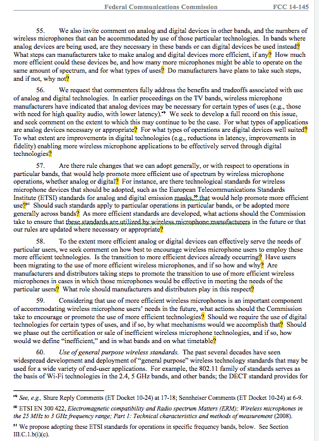
Above is a typical page with all the questions ending in question marks highlighted. There are 314 such questions and they appear on 49 different pages! Is that all? Of course not! The multiple authors of this document are very creative in making and hiding questions to make an exact count difficult. The word "seek" appears 158 times in such uses as
- "Further, we seek comment on proposals for authorizing wireless microphone operations in additional spectrum bands, consistent with the Commission’s overall spectrum management goals_ - para. 4
- "In addition, we seek comment on authorizing licensed wireless microphone operations in other bands. " - para. 30
- "We seek on comment on the different groups of wireless microphone operators and their various uses of microphones, including the particular applications served by the microphones, the types and number of devices used, the extent to which the devices are analog or digital, the settings in which they are used, and the frequency bands they use. " - para. 33
- "We also seek comment on the nature of the demand for wireless microphones by various wireless microphone users" - para. 38
Arguably some of the uses of "seek" in the text are not actually questions, so the count of 158 is a little high. But FCC staff has ways of asking questions without either the use of a question mark or the work "seek":
- "We ask that the different user groups, or the manufacturers of products for these groups, provide detailed information about the particular nature of wireless microphone uses by different groups of users." - para. 33
Your blogger actually compiled and submitted a list of all the 176 questions in Docket 14-177 (24+GHz 5G), but he does not have the patience to do the same in this tangled mess. As we have indicated in the posts mentioned earlier, both UK's Ofcom and Industry Canada number questions in their NOI and NPRM counterparts. Now some would say that they are not subject to the APA like FCC is, but having attended the FCBA reception at the Supreme Court last night, let me boldly say that I don't think the Supreme Court would remand an FCC decision just because its questions had numbers. It might remand a decision because it did not address the record and with so many tangled questions, how does one address the record?
The "Duplexer Gap" Issue Has Nothing to do With the Future of Local TV News!
National Association of Broadcasters, Radio & Television Digital News Association, Microsoft Corporation, Utilities Telecom Council, Wireless Internet Service Providers Association (WISPA), Engine Advocacy, Spectrum Bridge, Consumers Union, Consumer Federation of America, Open Technology Institute at New America, Public Knowledge, Free Press, Common Cause, Benton Foundation, Rural Broadband Policy Group, Institute for Local Self-Reliance, Access Humboldt, and Akaku Maui Community Media.
Kudos to those who were able to bring such a coalition together on any issue! We do not necessarily disagree with the bottom line of the letter with respect to preserving the duplex gap for unlicensed and wireless mic use, but we want to make clear:
Future of Local TV News Does Not Depend on Duplex Gap Spectrum!
The letter has several statements on this issue:
- “Placing television stations in the duplex gap …would significantly undercut the public interest benefits associated with the auction ..r by preventing both mobile news reporting and deployment of low-band unlicensed spectrum in the places where low-band spectrum is most needed to effectively provide these services.” p. 1
- “…eliminating reserved spectrum for wireless microphones could leave newsgathering operations without necessary spectrum to cover breaking news.” p. 1
- “…preserving critical news reporting” - p. 2
- “The proposal would hamper reporting of breaking news in the most populous cities.” - p. 2
The above statements only make sense with respect to using the wireless microphones that are presently owned by TV stations. TV stations sell for prices in the order of millions of dollars. The value of their wireless mic equipment inventory is a negligible fraction of their net worth. While it is true that alternative spectrum wireless mics are not available in the US today, the main reason is the basic truism:
Free spectrum is always cheaper than any new technology!
And the wireless mic spectrum referred to in the letter is FREE spectrum using outdated technology!
Today’s Wireless Mic Spectrum is Both a Technological and Policy Anachronism
Maj. Armstrong - Inventor of FM
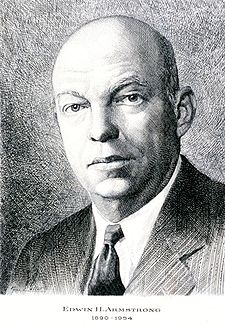
The irony is that even with the duplex gap available, in major cities theatrical productions, concerts and major sporting events will be hard put to use traditional wireless mic technology because of the near or complete elimination of virtual channels.
Since 1995 commercial spectrum users, e.g. broadcasters, have generally been expected to pay for spectrum use. Note that the PTC-related rail accident in Philadelphia highlighted the fact that Congress ordered he railroad industry to implement spectrum-based PTC but told them to buy spectrum access for existing licensees. Why do broadcasters feel they are entitled permanently to free spectrum access for wireless mics?
Is there a technological option? Yes at least one and certainly many others. But FCC's focus at throwing more spectrum at the problem removes any incentive for private capital formation for more efficient technology. Qualcomm developed several years ago a technology called FlashLinq for peer-to-peer communications in cellular spectrum under the control of cellular carriers similar tpthat way they control femtocells. This technology would allow cellular carriers to sell access to inevitable "white space" in their service areas that can only be used for lower power short range communications. Why is the product dead or dormant? Neither wireless mic users nor cellular carriers want anything to do with it! Wireless mic users are addicted to free spectrum and obsolescent technologies. Cellular carriers are addicted to the "killer app" mentality where they don't want a new service or revenue stream unless it is huge. Cellular operators can't fathom that eliminating other spectrum using by converting them to customers rather than fellow spectrum lustors might actually help their long range goals.
Today's smartphones are basically 2 way communications systems capable of sending and receiving 100s of kilobits or more of data. While your standard iPhone offers neither broadcast quality audio not easy access for sending high speed data from an external source, it is not rocket science to modify the interface to permits external high quality microphones with analog/digital convertors to interface with such a smartphone so the on the screen newsperson gets his/her audio out that way, not via Part 74 spectrum.
Other technical option are possible, but who would develop them given the present wireless mic policy impasse at FCC?
The issue of spectrum for concerts and theater is more complex technically because of both high quality audio requirements and requirements for minimum delay (less than 10 ms.). But again this does not seem impossible if FCC stops throwing spectrum at users with outdated technology who don't want to pay for spectrum.
So there may be reasons for keeping the "duplex gap", but the future of local news isn't one of them.
New Technologies for Wi-Fi
The unlicensed crowed has not been sitting on its hands while all this new technology has been developed on the cellular side. IEEE Communications magazine in its November 2014 issue has a focus on the “The Future of Wi-Fi”.
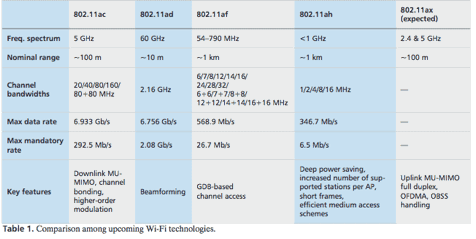
Above is a table from one of the Wi-Fi articles that gives some future versions of Wi-Fi along with their expected technical features.
These 4 papers give an overview of the new technologies that are expected to be implemented in licensed and unlicensed wireless communications in the next few years. The wireless mic gang might want to look at these technologies and ask why they are still obsessed with 1930s-based wideband FM. But other spectrum users, including federal users regulated by NTIA, might want to view these as a data point they should be judged by.
Fundamental Flaw of the Docket 14-165/6 4 MHz Wireless Mic Set-Aside:
Giving Free Spectrum for “Licensed Wireless Microphones” to Mostly Rich Corporations That Will Inevitably Be Very Lightly Used
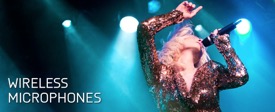
However, certain private entities decided to expand this de jure use with additional de facto use without the benefit of public policy deliberations and such use would appear to have been a criminal violation of §301. Yet the wireless mic industry, their non broadcast customers, and the FCC quietly looked the other way for decades. In Docket 01-75 the FCC described the NPRM as “an extensive review of the BAS rules and propose changes to create a more efficient BAS that can readily adapt to regulatory and technological changes.” The hypocrisy of the wireless mic industry is evident in the filing by Shure, Inc. in Docket 01-75, the only filing by any party interested in non broadcast/non film production use of wireless mics. At the time Shure was routinely marketing wireless mics to noneligible users by implying that they were Part 15 devices that did not need a license. The Shure reply comments state unambiguously in a heading:
![]()
(LPAS = Low Power Auxiliary Stations = Part 74, Subpart H)
The Shure filing goes on to cryptically mention on p. 4
While subtlely acknowledging illegal uses, they never asked that they be normalized and no other wireless mic user or manufacturer spoke at all in the 3 year long proceeding!“numerous activities conducted by businesses, religious and educational institutions, governmental bodies at all levels,law enforcement agencies, musical productions, and theatres (to name but a few). The American public relies heavily upon wireless audio equipment in the course of their daily work, worship, education and entertainment activities.”
In the new twin FCC NPRMs that deal with wireless mics, Dockets 14-165/166 we have the following proposed band plan for the “duplexer gap” between the cellular uplinks and downlinks in the repurposed 600 MHz TV spectrum after the incentive auction.
Note the 4 MHz orange colored block labeled “Licensed wireless microphones”. What is this block? It is restricted to the classic Part 74 eligibles (broadcasters CATV systems, and film producers) plus, as a result of a May 2014 R&O, the “Large venue owners or operators as defined in § 74.801 and Professional sound companies as defined in § 74.801”. The 2 new categories of users both have the requirement of routinely using 50 or more wireless microphones in productions. Note that while these entities have “licenses”, they are paying no apparent fees at all for spectrum access. (Broadcasters both application fees under §1.1104 and pay annual fees under §1.1153, but there do not appear to be any fees at all for wireless mic users in the litany of Part 1, Subpart G fees unlike virtually all commercial users.)
We note that for about 20 years, the general trend has been users of spectrum for commercial purposes pay for spectrum access. So the nonbroadcast wireless mic users are being rewarded for their illegal squatting up until 2010 with guaranteed access to spectrum at no cost at all! Who are these impoverished users? Here are two recent Internet ads from newly eligible users:

Could Lion King and their corporate parents at Disney afford to pay for spectrum use?


But the worst part of the proposal is that it is a return to the “Command & Control” spectrum model of the past that rewards special interests and contributes to the overall low occupancy of US spectrum. When averaged over the entire US and over the entire year, the 4 MHz set aside for “Licensed wireless microphones” will likely be the least utilized nonpublic safety spectrum in the US and may actually be the lowest utilized spectrum even considering public safety. (Public safety spectrum tends to have low utilization due to the bursty unpredictable nature of emergencies and the need to size the spectrum for the worst case incident.)
Yes, in a small section of Manhattan it will be used for a few hours a day. In Central Park and other concert venues it will be used for a few hours a few days of the year. Near some large churches it will be used a few hours a week. But the rest of the time it will be denied to all other users, both licensed and unlicensed. At present wireless mic licensed users have priority access to “vacant” TV channels. The new proposals will make them the sole possible user of 4 MHz, deny that spectrum 24/7 to other users even if there is no wireless mic use within 100 miles, and guarantee the very low utilization of that spectrum 24/7 in 50 states plus territories. Why?
So you ask how would your blogger deal with spectrum for wireless mics? He would have a set aside for wireless mics, but it would be much smaller, it would have a spectrum efficiency standard similar to Part 90, and it would apply to only small wireless mic system users who can not afford the transactions costs of a normal licensed system. Thus eligible users would be wireless mics in office conference rooms, places of worship with modest audio systems, and hotels for DJs and conferences. Perhaps a 10 microphone maximum. For bigger users who need high reliability, they would have to pay for spectrum access either through a variant of the UK system spectrum leasing system managed by Arqiva or through a femtocell-like system provide by cellular operators. For more details on the femtocell-like alternative, see an interview with your blogger in the wireless mic blog RF Venue.
In the UK,all wireless mic users (PMSE in UK jargon) have been paying for spectrum for over a decade. Has it resulted in the “the day the music died”?
This 4 MHz proposal is the worst example of Command & Control spectrum policy since it was discredited in the Spectrum Policy Task Force report in 2002!
UPDATE
For a very different point of view, try this piece from NPR. (Oddly, it also uses Lion King as an example, but doesn’t mention the ticket price. FYI, in London where Disney has to pay for spectrum for wireless mics/PMSE, the cost of seats near the front is £70.75 - £90.00 ($111- $141) so less than in NYC with present “free spectrum”.)
Our recent FCC filing in Docket 14-166 expands on the above discussion.
Olympic News: Wireless Mics Work Well in a Marketplace Environment!
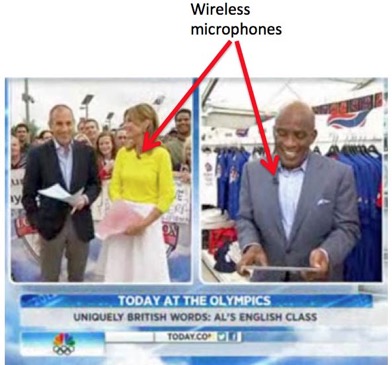
Watching the Olympics, you might not have noticed an interesting spectrum policy point: Wireless microphones (mics) are being used widely without any technical problems in a spectrum policy environment very different from the US: wireless mic users like most other spectrum users in the UK (including military users) are paying for spectrum access!
As we enter the era of incentive auctions, one of the issues people in Washington do not want to talk about is the future of wireless mics and their current spectrum. Clearly wireless mics are a socially constructive and economically important use of spectrum for the entertainment industry, conference facilities, and other applications. But wireless mics developed in the US on the assumption that interstitial use of “vacant” TV channels was a “free good”. Under NTSC analog technology with the UHF taboos resulting from poor TV receiver technology, or at least poor predictions of TV receiver technology, this was mostly true. Of course, the questionable large scale marketing by companies like Shure, Inc. of wireless mics to users not legally eligible to use them only complicated the issue.
Similarly the unwillingness of the entertainment users of wireless mics to confront the legal contradictions of using the technology as a key building block of their shows until Docket 04-186 showed up was also irresponsible, (One wonders about Walt Disney Co. with respect to its dual roles as a TV broadcasters with multiple licenses and the owner of Broadway shows that violated the Communications Act through their illegal use of wireless mics until recently. Had their lawyers done a risk analysis of this issue?)
It does not take much of a crystal ball to see that in the long term wireless mic use of UHF-TV spectrum will become questionable as this spectrum is in greater and greater demand. While mire less mics are important, their use is very sparse in space and time and normal allocation models are not a good match.
In the UK, Ofcom’s “dedicated band manager” for “programme-making and special events”/PMSE is JFMG, which is now owned by Arqiva, the company that actually owns and operates broadcast transmitters in the UK - operated on behalf of the programming originators. JFMG buys spectrum at market prices and then leases it for PMSE uses such as wireless mics to users who pay according to the amount of resources they use.
As we have seen in the Olympics it works! I suppose NBC would have preferred the US system where spectrum access is free. But why is that so important? While marketplace forces do not work all the time for all applications, the UK-style system is probably a better way to handle the wireless mic problem and will ease the inevitable transition to new technologies in various bands. Does anything think FCC really has the patience to handle that well?
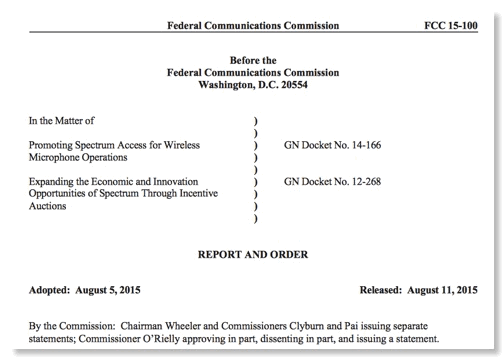
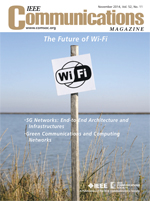




![Validate my RSS feed [Valid RSS]](valid-rss-rogers.png)

